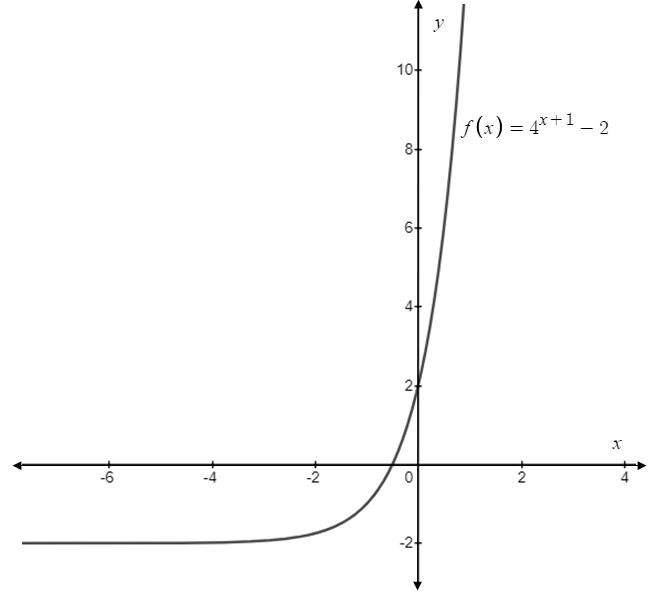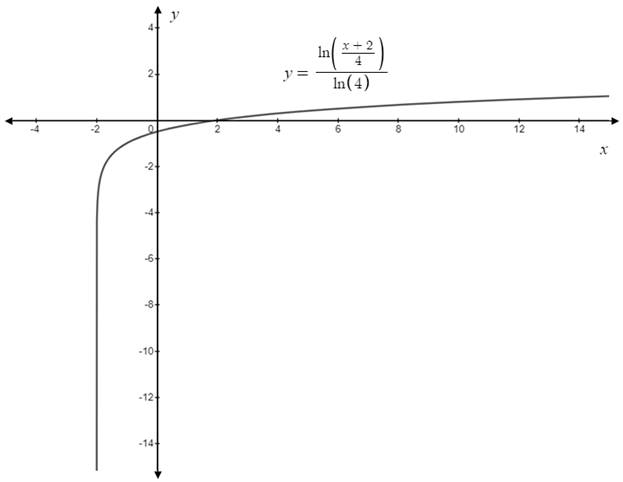
Concept explainers
(a)
The domain of
(a)
Answer to Problem 12CT
Solution:
The domain of the function
Explanation of Solution
Given information:
The function is
Consider the function
The given function can be written as
The given function is exponential function.
The domain of the exponential function is
Thus, the domain of the function
(b)
To graph: The function
(b)
Explanation of Solution
Given information:
The function is
Graph:
Use the steps below to graph the function using graphing calculator:
Step I: Press the ON key.
Step II: Now, press [Y=]. Input the right hand side of the function
Step III: Then hit [Graph] key to view the graph.
The graph of the function

Interpretation:
By looking at the graph, it is observed that as
(c)
The range of any asymptotes from the graph of
(c)
Answer to Problem 12CT
Solution:
1) The range of the function
2) The horizontal asymptote of
Explanation of Solution
Given information:
The function is
The domain of the function
Range of the function is the set of values of the dependent variable for which a function is defined.
From the graph, range of
As
Therefore, the horizontal asymptote of
(d)
The inverse of
(d)
Answer to Problem 12CT
Solution:
The inverse of
Explanation of Solution
Given information:
The function is
Consider the function
Step 1: Replace
Step 2: Interchange the variables
Interchange the variables
Step 3: Solve for
Add
Taking natural logarithm function from both sides of
By using
By using
Replace
Therefore, the inverse of
(e)
The domain and range of
(e)
Answer to Problem 12CT
Solution:
The domain of
Explanation of Solution
Given information:
The function is
From the part (d),
The logarithm function is defined only for positive real numbers.
The domain of the function is the set of real numbers such that
The domain of
The domain of the function
By using domain of
The range of
Therefore, the domain of
(e)
To graph: The function
(e)
Explanation of Solution
Given information:
The function is
Graph:
From the part (d),
Use the steps below to graph the function using graphing calculator:
Step I: Press the ON key.
Step II: Now, press [Y=]. Input the right hand side of the function
Step III: Then hit [Graph] key to view the graph.
By using the graphing calculator, the graph of the function

Interpretation:
By looking at the graph, it is observed that as
Chapter 5 Solutions
Precalculus Enhanced with Graphing Utilities
Additional Math Textbook Solutions
A Problem Solving Approach To Mathematics For Elementary School Teachers (13th Edition)
Elementary Statistics: Picturing the World (7th Edition)
University Calculus: Early Transcendentals (4th Edition)
Calculus: Early Transcendentals (2nd Edition)
Calculus for Business, Economics, Life Sciences, and Social Sciences (14th Edition)
Elementary Statistics (13th Edition)
- 74. Geometry of implicit differentiation Suppose x and y are related 0. Interpret the solution of this equa- by the equation F(x, y) = tion as the set of points (x, y) that lie on the intersection of the F(x, y) with the xy-plane (z = 0). surface Z = a. Make a sketch of a surface and its intersection with the xy-plane. Give a geometric interpretation of the result that dy dx = Fx F χ y b. Explain geometrically what happens at points where F = 0. yarrow_forwardExample 3.2. Solve the following boundary value problem by ADM (Adomian decomposition) method with the boundary conditions მი მი z- = 2x²+3 дг Əz w(x, 0) = x² - 3x, θω (x, 0) = i(2x+3). ayarrow_forward6. A particle moves according to a law of motion s(t) = t3-12t2 + 36t, where t is measured in seconds and s is in feet. (a) What is the velocity at time t? (b) What is the velocity after 3 s? (c) When is the particle at rest? (d) When is the particle moving in the positive direction? (e) What is the acceleration at time t? (f) What is the acceleration after 3 s?arrow_forward
- Construct a table and find the indicated limit. √√x+2 If h(x) = then find lim h(x). X-8 X-8 Complete the table below. X 7.9 h(x) 7.99 7.999 8.001 8.01 8.1 (Type integers or decimals rounded to four decimal places as needed.)arrow_forwardUse the graph to find the following limits. (a) lim f(x) (b) lim f(x) X-1 x→1 (a) Find lim f(x) or state that it does not exist. Select the correct choice X-1 below and, if necessary, fill in the answer box within your choice. OA. lim f(x) = X-1 (Round to the nearest integer as needed.) OB. The limit does not exist. Qarrow_forwardOfficials in a certain region tend to raise the sales tax in years in which the state faces a budget deficit and then cut the tax when the state has a surplus. The graph shows the region's sales tax in recent years. Let T(x) represent the sales tax per dollar spent in year x. Find the desired limits and values, if they exist. Note that '01 represents 2001. Complete parts (a) through (e). Tax (in cents) T(X)4 8.5 8- OA. lim T(x)= cent(s) X-2007 (Type an integer or a decimal.) OB. The limit does not exist and is neither ∞ nor - ∞. Garrow_forward
- Decide from the graph whether each limit exists. If a limit exists, estimate its value. (a) lim F(x) X➡-7 (b) lim F(x) X-2 (a) What is the value of the limit? Select the correct choice below and, if necessary, fill in the answer box within your choice. OA. lim F(x) = X-7 (Round to the nearest integer as needed.) OB. The limit does not exist. 17 Garrow_forwardFin lir X- a= (Us -10 OT Af(x) -10- 10arrow_forwardFind all values x = a where the function is discontinuous. For each value of x, give the limit of the function as x approaches a. Be sure to note when the limit doesn't exist. f(x)=4x²+7x+1 Select the correct choice below and, if necessary, fill in the answer box(es) to complete your choice. (Use a comma to separate answers as needed.) OA. f is discontinuous at the single value x = B. f is discontinuous at the single value x = OC. f is discontinuous at the two values x = OD. fis discontinuous at the two values x = OE. f is discontinuous at the two values x = The limit is The limit does not exist and is not co or - oo. The limit for the smaller value is The limit for the larger value is The limit for both values do not exist and are not co or - co. The limit for the smaller value does not exist and is not oo or - co. The limit for the larger value isarrow_forward
- Find all values x = a where the function is discontinuous. For each value of x, give the limit of the function as x approaches a. Be sure to note when the limit doesn't exist. 8+x f(x) = x(x-1) (Use a comma to separate answers as needed.) OA. The function f is discontinuous at the single value x = OB. The function f is discontinuous at the single value x = OC. The function f is discontinuous at the two values x = OD. The function f is discontinuous at the two values x = not oo or -0. OE. The function f is discontinuous at the two values x = The limit is The limit does not exist and is not oo or - co. The limits for both values do not exist and are not co or - co. The limit for the smaller value is The limit for the larger value does not exist and is The limit for the smaller value does not exist and is not co or - co. The limit for the largerarrow_forwardi need help please . and please dont use chat gpt i am trying to learn and see the mistake i did when solving minearrow_forwardi need help please . and please dont use chat gpt i am trying to learn and see the mistake i did when solving minearrow_forward
 Calculus: Early TranscendentalsCalculusISBN:9781285741550Author:James StewartPublisher:Cengage Learning
Calculus: Early TranscendentalsCalculusISBN:9781285741550Author:James StewartPublisher:Cengage Learning Thomas' Calculus (14th Edition)CalculusISBN:9780134438986Author:Joel R. Hass, Christopher E. Heil, Maurice D. WeirPublisher:PEARSON
Thomas' Calculus (14th Edition)CalculusISBN:9780134438986Author:Joel R. Hass, Christopher E. Heil, Maurice D. WeirPublisher:PEARSON Calculus: Early Transcendentals (3rd Edition)CalculusISBN:9780134763644Author:William L. Briggs, Lyle Cochran, Bernard Gillett, Eric SchulzPublisher:PEARSON
Calculus: Early Transcendentals (3rd Edition)CalculusISBN:9780134763644Author:William L. Briggs, Lyle Cochran, Bernard Gillett, Eric SchulzPublisher:PEARSON Calculus: Early TranscendentalsCalculusISBN:9781319050740Author:Jon Rogawski, Colin Adams, Robert FranzosaPublisher:W. H. Freeman
Calculus: Early TranscendentalsCalculusISBN:9781319050740Author:Jon Rogawski, Colin Adams, Robert FranzosaPublisher:W. H. Freeman
 Calculus: Early Transcendental FunctionsCalculusISBN:9781337552516Author:Ron Larson, Bruce H. EdwardsPublisher:Cengage Learning
Calculus: Early Transcendental FunctionsCalculusISBN:9781337552516Author:Ron Larson, Bruce H. EdwardsPublisher:Cengage Learning





